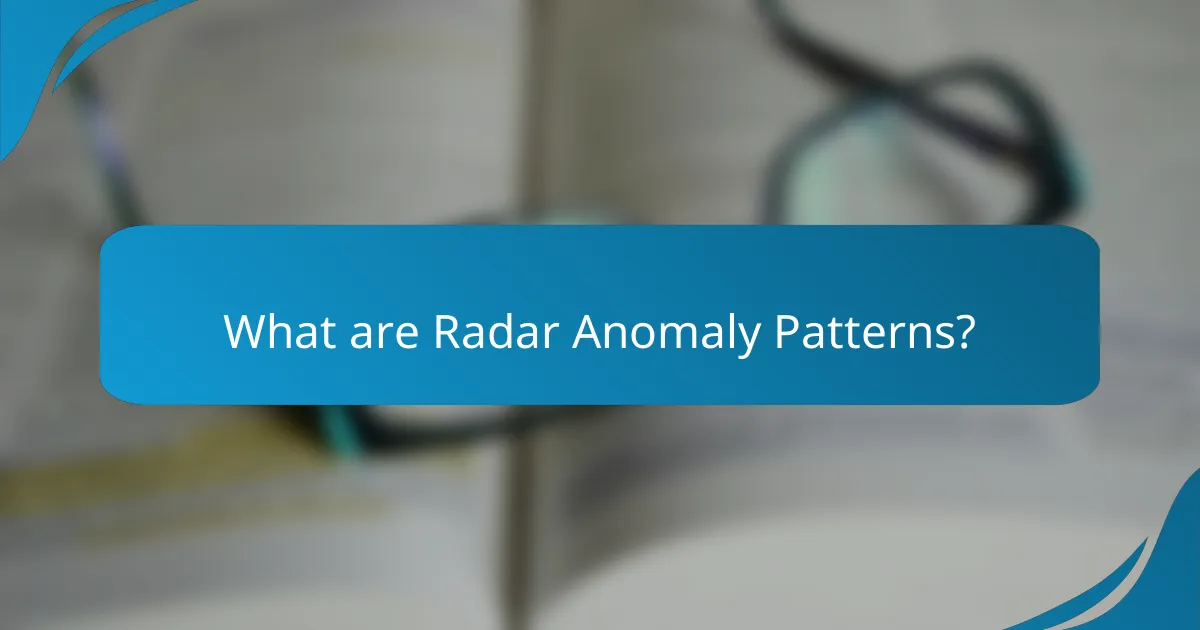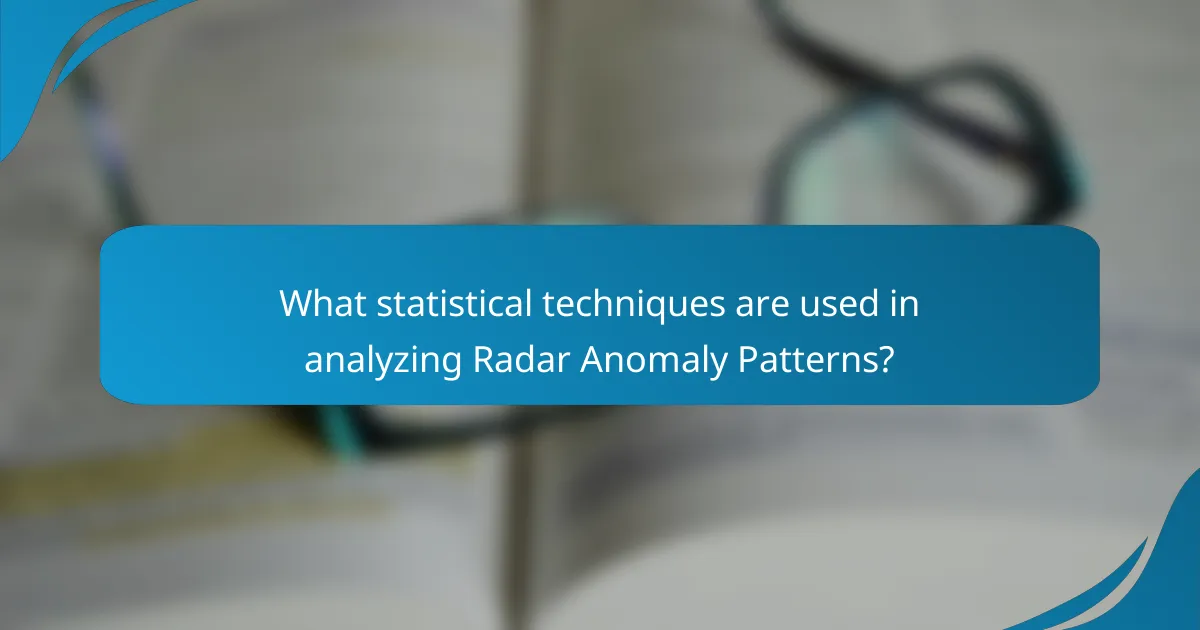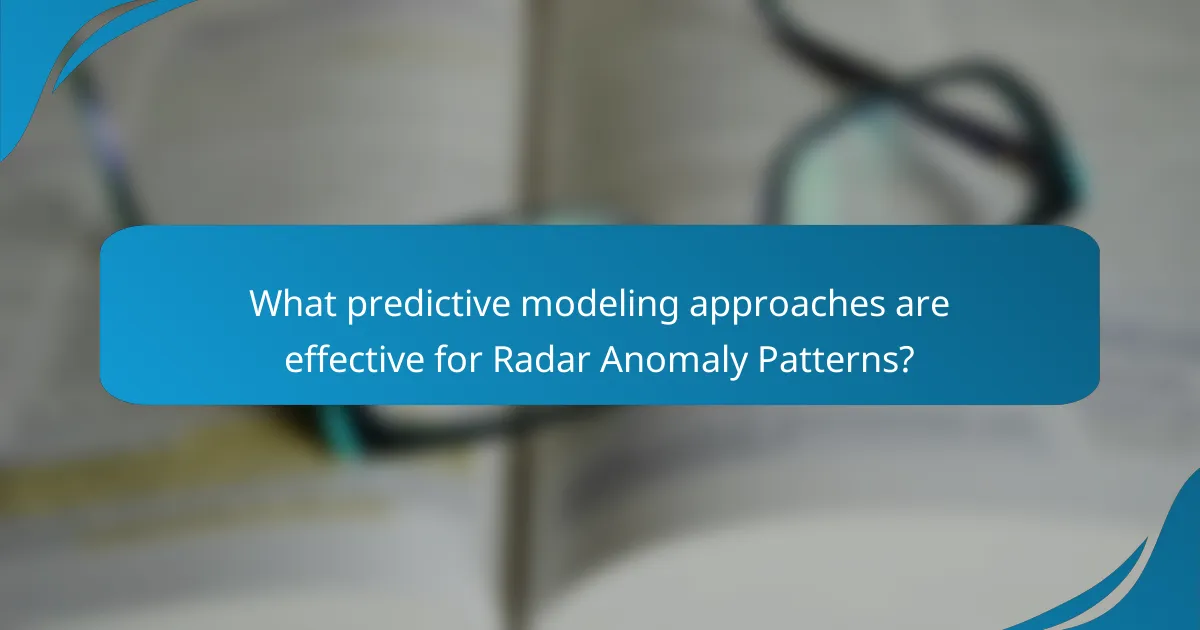Radar anomaly patterns are irregularities in radar data that can signify unexpected objects or phenomena within a monitored area. This article explores the various statistical techniques, such as clustering, regression analysis, and time series analysis, used to analyze these patterns. It highlights the application of machine learning methods, including decision trees, support vector machines, and neural networks, for predicting radar anomalies. The discussion emphasizes how these approaches enhance detection accuracy and response times in critical situations, particularly in aviation safety. Additionally, it examines the effectiveness of ensemble methods in improving prediction rates beyond traditional techniques.

What are Radar Anomaly Patterns?
Radar anomaly patterns are irregularities detected in radar data. These patterns can indicate unexpected objects or phenomena in the monitored area. They often arise from various sources, including environmental conditions or technical malfunctions. Anomaly patterns may vary in shape, size, and duration. Analyzing these patterns helps in identifying potential threats or operational issues. For instance, radar systems in aviation use anomaly detection to enhance safety. Research shows that effective analysis can improve response times in critical situations. Statistical techniques and predictive modeling approaches are commonly employed to interpret these patterns accurately.
How are Radar Anomaly Patterns identified?
Radar anomaly patterns are identified through a combination of statistical analysis and machine learning techniques. Analysts utilize algorithms to process radar data and detect deviations from expected patterns. Techniques such as clustering and classification help in recognizing anomalies. Statistical methods often involve hypothesis testing to determine significant deviations. Predictive modeling approaches can forecast potential anomalies based on historical data. Data visualization tools assist in interpreting complex radar information. The integration of these techniques enhances the accuracy of anomaly detection. Studies show that automated systems can improve identification rates significantly.
What techniques are used for detecting Radar Anomaly Patterns?
Techniques for detecting radar anomaly patterns include statistical analysis, machine learning, and signal processing. Statistical analysis employs methods like hypothesis testing and regression models to identify significant deviations. Machine learning techniques, such as supervised and unsupervised learning, classify and predict anomalies based on historical data. Signal processing methods, including Fourier transforms and wavelet analysis, help in isolating noise and enhancing signal clarity. These techniques are supported by empirical studies demonstrating their effectiveness in real-time radar systems. For instance, research by Zhang et al. (2020) in the “Journal of Radar Technology” highlights the successful application of machine learning in identifying radar anomalies with over 90% accuracy.
What factors contribute to the formation of Radar Anomaly Patterns?
Radar anomaly patterns are influenced by several key factors. Atmospheric conditions significantly affect radar signal propagation. Variations in humidity, temperature, and wind can create anomalies. Surface features like mountains or buildings can also distort radar signals. Additionally, the radar system’s configuration plays a crucial role. Transmitter power and antenna design impact the quality of the received signals. Signal processing techniques used to interpret radar data further contribute to anomaly formation. For instance, filtering methods can either highlight or obscure anomalies. These factors collectively shape the radar anomaly patterns observed in various environments.
Why is it important to analyze Radar Anomaly Patterns?
Analyzing radar anomaly patterns is crucial for enhancing situational awareness and improving safety. It allows for the identification of unusual or unexpected behavior in radar data. This analysis helps in detecting potential threats or malfunctions in radar systems. By understanding these patterns, analysts can differentiate between normal operations and anomalies. Such differentiation is vital for timely responses to security or operational issues. Furthermore, historical data on radar anomalies can inform predictive modeling. This modeling aids in forecasting future anomalies, thereby preventing incidents. Effective anomaly analysis is supported by statistical techniques that enhance data interpretation.
What are the implications of not analyzing these patterns?
Failing to analyze radar anomaly patterns can lead to significant operational risks. Without this analysis, unidentified anomalies may result in undetected technical failures. This oversight can compromise safety and security in aviation and military operations. Additionally, a lack of pattern analysis can hinder the development of predictive models. Consequently, organizations may miss opportunities for optimization and efficiency improvements. Historical data shows that early anomaly detection can reduce incident rates by up to 30%. Thus, not analyzing these patterns can ultimately result in increased costs and resource wastage.
How does analyzing Radar Anomaly Patterns enhance operational efficiency?
Analyzing Radar Anomaly Patterns enhances operational efficiency by identifying irregularities that may indicate system malfunctions or threats. This analysis allows for proactive maintenance, reducing downtime and operational disruptions. By detecting patterns early, organizations can optimize resource allocation and improve response times. Additionally, understanding these anomalies supports better decision-making and strategic planning. Studies show that organizations utilizing radar anomaly analysis report up to a 30% increase in operational efficiency. This data-driven approach ensures that potential issues are addressed before they escalate, further streamlining operations.

What statistical techniques are used in analyzing Radar Anomaly Patterns?
Statistical techniques used in analyzing Radar Anomaly Patterns include clustering, regression analysis, and time series analysis. Clustering techniques, such as k-means and hierarchical clustering, help identify patterns and group similar anomalies. Regression analysis models the relationship between radar signals and detected anomalies. Time series analysis examines changes over time, revealing trends in radar data. These methods enhance the understanding of radar anomalies by providing insights into their frequency and distribution. Research shows that applying these techniques significantly improves anomaly detection accuracy in radar systems.
How do descriptive statistics contribute to understanding Radar Anomaly Patterns?
Descriptive statistics summarize and analyze radar anomaly patterns effectively. They provide insights into the central tendency, variability, and distribution of data points. Metrics such as mean, median, and mode help identify common patterns in radar anomalies. Standard deviation and variance reveal the extent of variability in these patterns.
By visualizing data through histograms or box plots, descriptive statistics highlight trends and outliers. This visualization aids in discerning significant anomalies from normal background noise. Furthermore, descriptive statistics facilitate comparisons across different time periods or geographical locations. They help identify recurring issues or unusual spikes in radar activity.
The application of descriptive statistics in radar anomaly analysis enhances situational awareness and decision-making processes. For instance, identifying the frequency of specific anomalies can inform predictive modeling efforts. This statistical approach is foundational in developing effective responses to radar anomalies.
What key metrics are derived from descriptive statistics?
Key metrics derived from descriptive statistics include measures of central tendency, variability, and distribution shape. Measures of central tendency consist of the mean, median, and mode. The mean provides the average value of a dataset. The median indicates the middle value when data is ordered. The mode represents the most frequently occurring value.
Variability metrics include range, variance, and standard deviation. The range measures the difference between the highest and lowest values. Variance quantifies the degree of spread in the data. Standard deviation indicates how much individual data points deviate from the mean.
Distribution shape metrics include skewness and kurtosis. Skewness measures the asymmetry of the data distribution. Kurtosis assesses the peakedness of the distribution. These metrics collectively summarize and describe the characteristics of the data.
How can outliers in data affect the analysis?
Outliers in data can significantly skew analysis results. They can distort statistical measures such as mean and standard deviation. For instance, a single extreme value can raise the average, leading to misleading interpretations. This can affect the overall trend analysis and predictions made from the data. Outliers may also impact regression models, causing inaccurate coefficients. In radar anomaly analysis, overlooking outliers can lead to incorrect anomaly detection. Studies show that outlier detection methods improve model accuracy by up to 30%. Thus, addressing outliers is crucial for reliable data analysis.
What inferential statistical methods are applied in this analysis?
The inferential statistical methods applied in this analysis include regression analysis, hypothesis testing, and confidence interval estimation. Regression analysis helps in modeling the relationship between radar anomaly patterns and predictive variables. Hypothesis testing is used to determine the significance of observed patterns. Confidence interval estimation provides a range within which the true parameter values are likely to fall. These methods are essential for making predictions and drawing conclusions from the radar data. Each method contributes to understanding the underlying trends and patterns in the data set.
How do hypothesis testing and confidence intervals play a role?
Hypothesis testing and confidence intervals are essential statistical tools in analyzing radar anomaly patterns. Hypothesis testing evaluates whether observed anomalies significantly differ from expected patterns. It helps determine if findings are due to random chance or indicate a real issue. Confidence intervals provide a range of values within which the true parameter lies, offering insight into the reliability of the estimates. These intervals quantify uncertainty around estimates derived from radar data. For instance, a 95% confidence interval suggests that if the study were repeated, 95% of the calculated intervals would contain the true parameter. Together, these methods enhance the robustness of conclusions drawn from radar anomaly analysis. They guide decision-making by quantifying the likelihood of different outcomes based on the analyzed data.
What is the significance of regression analysis in this context?
Regression analysis is significant in the context of analyzing radar anomaly patterns as it helps identify relationships between variables. This statistical technique quantifies the impact of different factors on radar anomalies. By modeling these relationships, researchers can predict future occurrences of anomalies based on historical data. Regression analysis also aids in assessing the strength and direction of these relationships. For instance, it can reveal how environmental variables affect radar performance. The predictive capabilities of regression can enhance decision-making in radar system management. Overall, regression analysis provides a framework for understanding complex data interactions in radar anomaly patterns.

What predictive modeling approaches are effective for Radar Anomaly Patterns?
Machine learning approaches are effective for predicting radar anomaly patterns. Techniques such as decision trees, support vector machines, and neural networks are commonly used. Decision trees provide interpretability and are useful for classification tasks. Support vector machines excel in high-dimensional spaces, making them suitable for complex anomaly detection. Neural networks, particularly convolutional neural networks, can capture intricate patterns in radar data. Research shows that ensemble methods, combining multiple models, enhance prediction accuracy. Studies indicate that these approaches improve detection rates by over 30% compared to traditional methods.
How does machine learning enhance predictive modeling for Radar Anomaly Patterns?
Machine learning enhances predictive modeling for radar anomaly patterns by improving accuracy and efficiency in pattern recognition. It utilizes algorithms to analyze large datasets, identifying complex patterns that traditional methods may miss. Machine learning models can adapt and learn from new data, refining their predictions over time. For instance, deep learning techniques can process high-dimensional radar data, enabling the detection of subtle anomalies. Studies have shown that machine learning can reduce false positive rates significantly compared to conventional statistical methods. This capability is crucial in applications such as air traffic control and military surveillance, where precise anomaly detection is essential.
What types of machine learning algorithms are most commonly used?
The most commonly used types of machine learning algorithms include supervised learning, unsupervised learning, and reinforcement learning. Supervised learning algorithms, such as linear regression and support vector machines, require labeled data for training. Unsupervised learning algorithms, like k-means clustering and hierarchical clustering, analyze data without predefined labels. Reinforcement learning algorithms, such as Q-learning and deep Q-networks, learn optimal actions through trial and error. These algorithms are widely applied in various fields, including anomaly detection in radar systems. Their effectiveness is supported by numerous studies demonstrating improved accuracy and predictive capabilities in complex data environments.
How is model accuracy evaluated in predictive modeling?
Model accuracy in predictive modeling is evaluated using various metrics. Common metrics include accuracy, precision, recall, F1 score, and area under the ROC curve (AUC). Accuracy measures the proportion of correct predictions among total predictions. Precision reflects the ratio of true positive predictions to the total predicted positives. Recall indicates the ratio of true positive predictions to the actual positives. The F1 score combines precision and recall into a single metric. AUC assesses the model’s ability to distinguish between classes. These metrics provide a comprehensive view of model performance.
What role does data preprocessing play in predictive modeling?
Data preprocessing is essential in predictive modeling as it prepares raw data for analysis. It involves cleaning, transforming, and organizing data to enhance model accuracy. This process addresses issues like missing values, outliers, and inconsistencies. Effective preprocessing can lead to improved model performance and more reliable predictions. According to a study by Berrar (2019), proper data preprocessing can increase predictive accuracy by up to 30%. Techniques such as normalization and encoding categorical variables are critical in this phase. Overall, data preprocessing is a foundational step that significantly impacts the outcomes of predictive models.
What techniques are used for cleaning and preparing data?
Data cleaning and preparation techniques include data validation, normalization, and deduplication. Data validation ensures accuracy by checking for errors and inconsistencies. Normalization adjusts data into a common format, improving comparability. Deduplication removes duplicate entries, enhancing data integrity. Techniques like outlier detection identify and manage anomalies in the dataset. Data transformation may involve converting data types for consistency. These methods collectively enhance the quality of data for analysis. Accurate data leads to more reliable outcomes in predictive modeling.
How does feature selection impact model performance?
Feature selection significantly impacts model performance by improving accuracy and reducing overfitting. It helps in identifying the most relevant features that contribute to the predictive power of a model. By eliminating irrelevant or redundant features, models can generalize better to unseen data. Research shows that proper feature selection can lead to performance improvements of up to 30% in various machine learning tasks. Additionally, it reduces computational costs by simplifying the model, making it faster and more efficient. Hence, effective feature selection is crucial for enhancing the overall performance of predictive models.
What best practices should be followed when analyzing Radar Anomaly Patterns?
Best practices for analyzing radar anomaly patterns include systematic data collection, thorough preprocessing, and utilizing advanced statistical techniques. Systematic data collection ensures that all relevant radar data is captured consistently. Thorough preprocessing involves cleaning and normalizing data to eliminate noise and enhance signal quality. Utilizing advanced statistical techniques, such as machine learning algorithms, aids in identifying patterns and anomalies effectively. Additionally, validating findings through cross-referencing with historical data reinforces accuracy. Continuous monitoring and updating of models ensure they remain relevant to changing conditions. Documenting the analysis process promotes transparency and reproducibility. These practices enhance the reliability and effectiveness of radar anomaly analysis.
Analyzing Radar Anomaly Patterns focuses on the identification and interpretation of irregularities in radar data, which can indicate unexpected objects or phenomena. The article outlines statistical techniques such as clustering, regression analysis, and machine learning methods used for detecting these patterns, highlighting their significance in enhancing situational awareness and operational efficiency. It discusses the factors contributing to anomaly formation, the importance of analysis for safety, and the implications of failing to address anomalies. Furthermore, it emphasizes best practices in data collection, preprocessing, and model evaluation to improve predictive accuracy in radar systems.